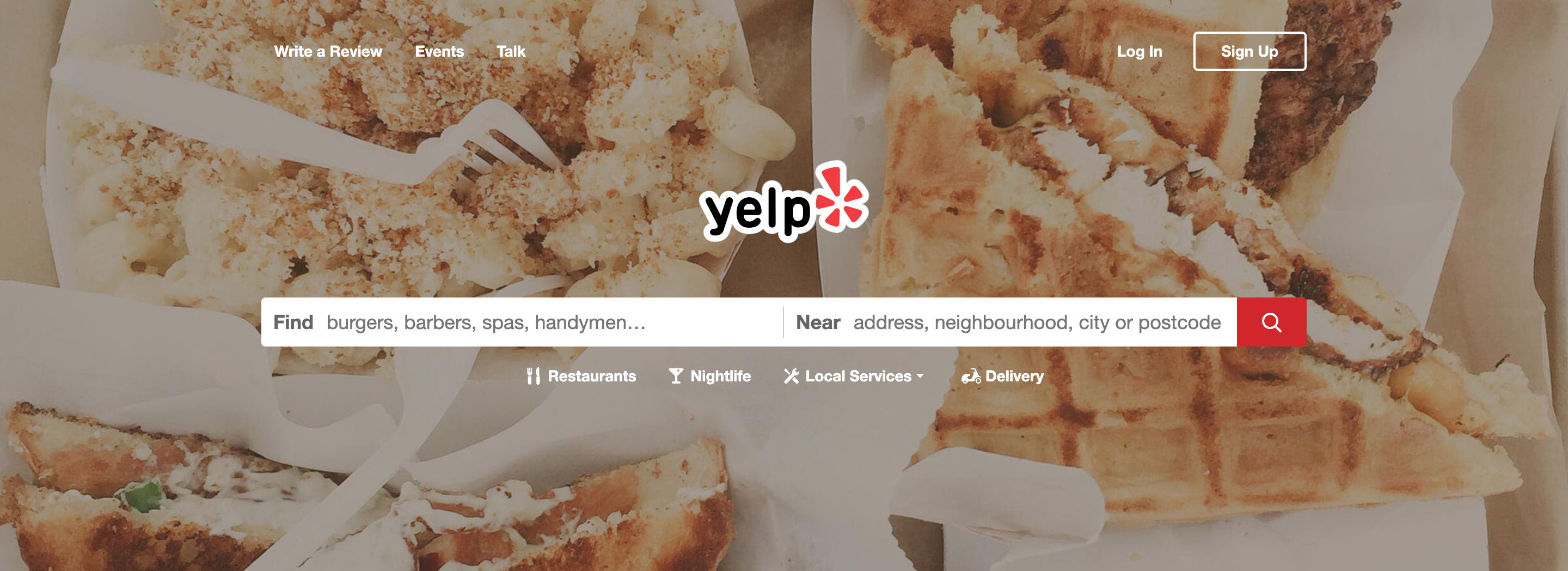When it comes to making a purchase decision, the majority of potential customers will look to reviews for help.
It doesn’t matter whether this is choosing a restaurant, booking a holiday, or picking somewhere to visit at the weekend; what other people have to say matters.
Yelp is a platform that allows customers to leave such reviews for the businesses they have visited and supported, from cafes to cottage rentals and everything in between.
Whilst (we hope) the majority of Yelp reviews you receive are positive and full of praise, there are always going to be times when a negative experience brings this average down. It’s important to bear in mind that your responses to these comments can have as much influence as the reviews themselves, both good and bad.
Responding to reviews is the best way you can demonstrate to customers and potential customers that you care about what they have to say. It gives you the chance to encourage repeat business, helps to highlight areas that need improvement, and builds a strong brand image that people will remember and favor over others.
Positive and negative Yelp reviews all warrant a reply, and dedicating the time and resources to doing so can have a big impact.
Here’s a complete guide to everything you need to know before you sit down and start responding.
Should You Respond to Yelp Reviews?

Whether they’re positive or negative, many people wonder whether they should bother to respond to Yelp reviews at all. It can be time-consuming to trawl through comments, and sometimes engaging with dissatisfied customers can bring more hassle than it’s worth.
However, responding to Yelp reviews has many benefits, and should be high on your list of priorities if you’re looking to improve customer engagement, build more brand loyalty and demonstrate your commitment to providing a quality service.
First of all, responding to all positive or negative reviews shows the customer who left them that you care about what people have to say about your business. This builds a sense of affiliation with your customers and makes them more likely to come back and leave good reviews again.
Responding to Yelp reviews also demonstrates to new customers that you are a business that takes their feedback seriously.
If a potential customer comes to your Yelp review page and sees that you have taken the time to respond to feedback and praise, they’ll see you in a more positive light and be more likely to buy from you.
Finally, reading and responding to reviews on Yelp gives you a direct way to hear what your customers are saying about your business, identify what is working well and what needs improvement, and also have conversations with real customers about how your offering can be improved.
Before you start sending responses to Yelp reviews, it can be helpful to clarify a response protocol or designate the role of the responder to a member of your team. This ensures that you establish a strong image with your responses and that customers know what to expect.
You can use the following advice to inform your Yelp reviews response protocol.
How to Respond to Positive Reviews on Yelp
A positive review is like gold dust for a business.
When a customer takes the time to tell you just how impressed they are with your offering, you know that you’re doing something right.
Surely, you can just sit back and bask in the post-praise glow now?
Nope.
If you want to give that warm, fuzzy feeling to the customer who left a review in the first place, you need to respond to their comment.
It might feel like overkill, but replying to positive reviews is just as important as replying to negative ones. This makes the customer feel good about saying something nice, increasing the likelihood that they come back to your business, tell their friends about you and your excellent customer service, and leave another positive review again.
Here are some top tips for responding to positive Yelp customer reviews.
Keep It Short
It’s important to give a meaningful response to your customer’s reviews, but you don’t want to overdo it.
When writing Yelp responses to positive comments, try to keep things as concise as possible whilst ensuring that you don’t sound sharp and impersonal.
A good rule of thumb is to use the following structure:
- One opening sentence.
- A paragraph of thanks for the review, around 3-4 sentences.
- One closing sentence.
This means that your reply will feel genuine and personal, but won’t ramble on for lines and lines and lose the attention of the reader.
Say Thank You
The most important thing to remember when responding to a positive Yelp review is to say thank you.
You can express gratitude in a variety of different ways, and it’s good to change up what you say so that your responses sound more genuine. But including thanks right at the start of your reply will make the customer instantly feel good about leaving a review and ensure that you appear humble but showing genuine appreciation.
Examples of ways to thank your customers are:
- “Thank you so much for reaching out!”
- “We’re so grateful that you took the time to let us know…”
- “It sounds like you had a great time, many thanks for leaving a review!”
- “Your kind words are really appreciated!”
- “That’s so great to hear, thanks a bunch for telling us what you thought!”
Read and Mirror Details
Before deciding what to respond to a Yelp review, take the time to read through what has been said and pick out the key details. Then, make sure that you mirror these details by including them in your response to demonstrate that you have paid attention to what has been said.
A lot of customers will expect that responses to positive reviews are automated. Picking out the key details will show that you took the time to listen to what they had to say and make each of your responses more personal.
For example, if you’re a holiday cottage rental business, and a customer has specifically praised the cleaning service that you offer your guests, your response could look like this:
“Hi, [customer name]! Thanks so much for taking the time to leave us such a glowing review!
We’re really pleased to hear that you felt that your cottage had been cleaned to a high standard when you arrived and that this encouraged you to make another booking with us. We pride ourselves on ensuring that our guests enjoy outstanding service for the entirety of their stay, and our cleaners are a part of that.”
Building on the praise you have been given offers an opportunity to reiterate some of the key benefits of your business, as you can see in the example above.
Make It Unique
As we’ve already mentioned, your responses mustn’t sound like automated messages. If a potential customer visits your Yelp page and sees that all reviews have the same, basic reply, they’ll assume that you don’t actually read them and will be much less inclined to leave one themselves.
Leaving unique reviews can be as simple as addressing the customer by name, highlighting and responding directly to some of the points they have made, and changing up the language you use to thank them.
This makes your customer service more personal and will also make your reviewers feel appreciated and acknowledged, building affiliation.
Offer More Value
Whether you include a discount or just some personalized advice in your responses, you can take your customer interaction to the next level by including something valuable in each of your replies.
Not only will this be an incentive for more positive reviews, but it’s also a good way to generate repeat business.
The added value you include doesn’t have to be something like an offer or discount code (although this works particularly well), but could just be a suggestion of something else a customer might enjoy.
For example, if you’re a travel agent or tour provider and a customer has praised the trip they recently took with you to the Italian Riviera, you might include advice on another part of Italy they would enjoy or a similar holiday package that you know other customers have rated highly.
Close with an Invitation
The final sentence of a response to a positive review should always be encouraging the customer to return or repurchase. This doesn’t have to be via a hard sell, but instead a friendly encouragement to continue supporting your business.
Examples of this closing invitation are:
- “We’ll see you soon!”
- “We look forward to your next visit!”
- “Until the next time, enjoy your…”
How to Respond to Negative Yelp Reviews
Almost every business receives a negative Yelp review from time to time. It might have been prompted by something out of your control, it might have been the result of an unintentional mistake, or it may just have been from a customer who was having a bad day.
The context of the complaint doesn’t really matter though. What matters is how you respond.
You can turn bad reviews on Yelp into opportunities to improve your service, build better relationships with your customer base and polish your brand image all at the same time.
Instead of flying off the hook or taking it personally, see this as an opportunity to do better and avoid similar situations in the future.
Knowing how to deal with bad Yelp reviews does partly come from experience, but the following advice should also be followed to ensure you make the best of a bad situation.
Respond Quickly
When it comes to bad reviews on Yelp, speed is everything.
If you’ve gotten a bad review, you want to tackle it as quickly and efficiently as possible before a lot of people see it and the negativity affects your business.
Having someone on your team regularly checking review sites like Yelp or using software to monitor for reviews is the best way to keep on top of all the feedback you’re getting and ensure that negative reviews don’t get missed.
This is particularly important when a customer is seeking a refund or an explanation for something that has happened.
Make the Message Personal
One of the most common pieces of advice when responding to Yelp reviews that aren’t full of praise is to use the name of the customer who has left the review, if it is available.
Not only does this demonstrate that a real person has taken the time to read and respond to their review, but addressing someone by their name can soften some of their anger or frustration and lead to a more positive interaction.
It turns a single, negative message into a personal conversation and indicates to other readers that you make an effort to engage with your customers on an individual level.
Begin with Thanks
In the same way that a response to a positive review should always begin with thanks, a negative should include thanking the customer as well.
This may sound counter-intuitive, but it indicates that you appreciate all the feedback that your customers leave and want to use it as an opportunity to improve. Which, of course, you should do.
You don’t have to use the same, enthusiastic tone that you would with a positive response, but should still make an effort to sound genuine.
Examples of this are:
- “Thank you for getting in touch to let us know what went wrong.”
- “We appreciate you bringing this to our attention.”
- “Thanks for flagging this up to us, we’re sorry to hear about your experience.”
Highlight Your Action
The most important thing you need to include in good responses to negative Yelp reviews is details of the action you have taken. This is important not only to placate the customer but also to demonstrate to other customers and potential customers that you take negative feedback seriously.
If a customer has pointed out a flaw in your system, complained about a mistake, or identified an area where your service is lacking, you should work to remove the issue immediately.
Once you have done this, include evidence in your response of what has been done to prevent the problem from happening again.
In the event of an issue that cannot be immediately resolved, you should still include a promise that you are looking into it and working on a resolution.
If a lot of attention has been paid to the review, you may benefit from giving your customers an update when a solution is found.
Keep Things Polite
Online reviews can be particularly harsh, and Yelp is no exception. Fighting fire with fire might feel like the most justified response, but it’s the worst thing you could do in these kinds of situations.
No matter how rude a customer might have been, always ensure that your bad Yelp review response is polite and courteous. This is essential for minimizing the impact of their negative comments and demonstrating that your business cares about their customers and how they are treated.
Responding rudely to negative feedback is one of the fastest ways to cause more damage to your reputation.
You wouldn’t (we hope) yell in the face of a customer making a complaint in person. Sitting behind a screen is no different.
End With Positivity
No matter how bad a review on Yelp may have been, try to always finish your response with positivity.
This may be in the form of a pleasant parting comment, a wish that the customer returns for a better experience, or another thank you for highlighting an issue in the first place.
You could also offer to give the customer a refund or a discount, or a solution to their problem if possible.
Ending on a positive note may not have much of an effect if the writer of the review is really unimpressed, but it does show other customers that you are trying to make amends and paints you in a positive light.
For example:
- “We hope you enjoy the rest of your trip!”
- “Thanks again for flagging this up, we appreciate you taking the time to give us feedback.”
- “We hope that your next experience with us is more positive.”
Track Your Feedback
Whenever you receive negative feedback, it’s always worth making a note of what was said, what aspect of your business was involved, and what action was taken in response.
Not only is it a good idea to keep records like this in case you need to reference past reviews at any point, but it also means that you will notice if any trends appear in the complaints you receive on Yelp.
For example, if you notice that a lot of your negative reviews are referencing an issue with your website or that customer service was lacking, this is a clear indication that you should make improvements in these areas to avoid any more negative feedback.
Conclusion
Your Yelp page is a place where customers come to feel heard, and replying to their reviews is the best way to ensure this.
Responding to reviews on Yelp might seem like a fruitless way to spend your time, but it’s actually one of the best methods of interacting directly with your customers, identifying which areas of your business offering need work, and demonstrating your commitment to delivering outstanding service.
Used correctly, the site can be one of the best ways to drive both new and repeat business. The better the impression you make with your responses, the more people will remember and support you.
More Resources:
- Yelp SEO: How to Optimize Your Listings & Rank Higher
- How to Build Links Using Testimonials & Reviews
- Local SEO: The Definitive Guide to Improve Your Local Search Rankings
Image Credit
Screenshot taken by author, June 2021





